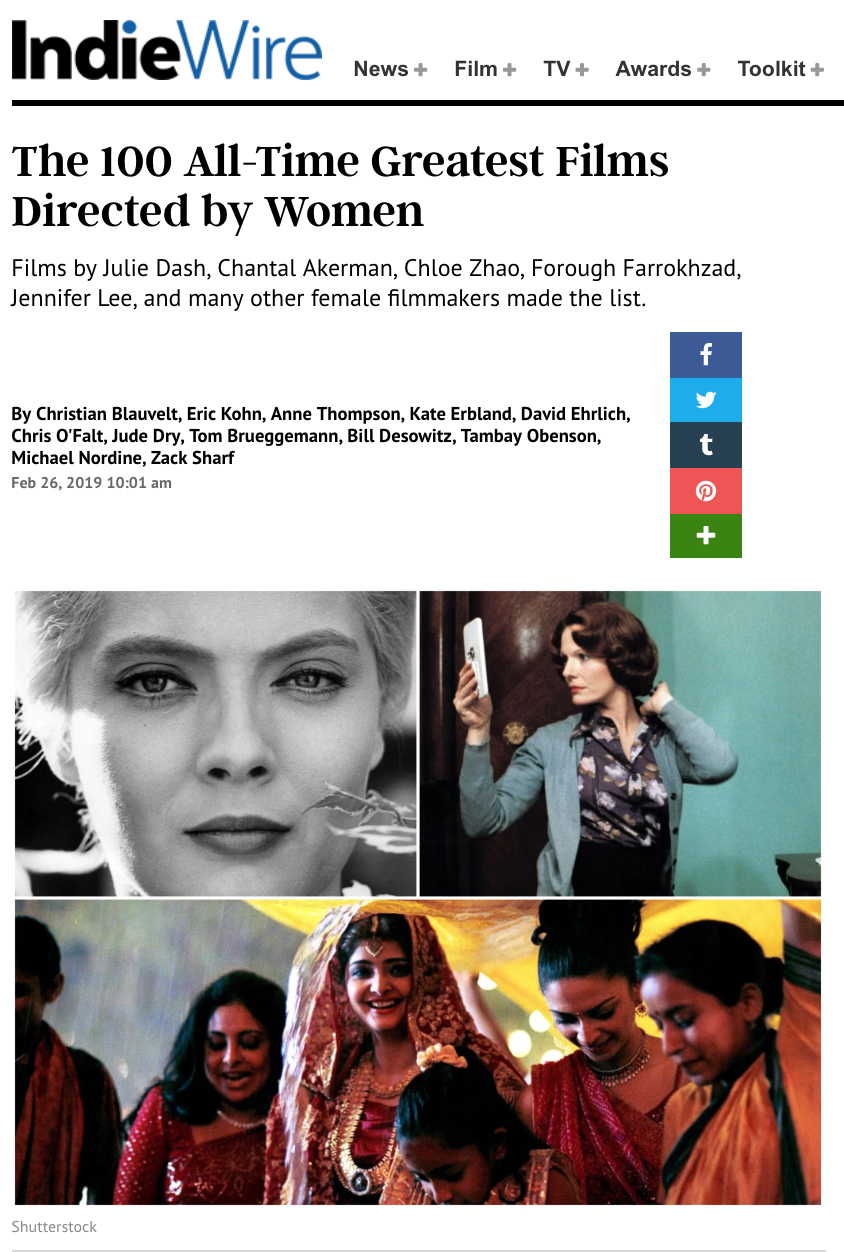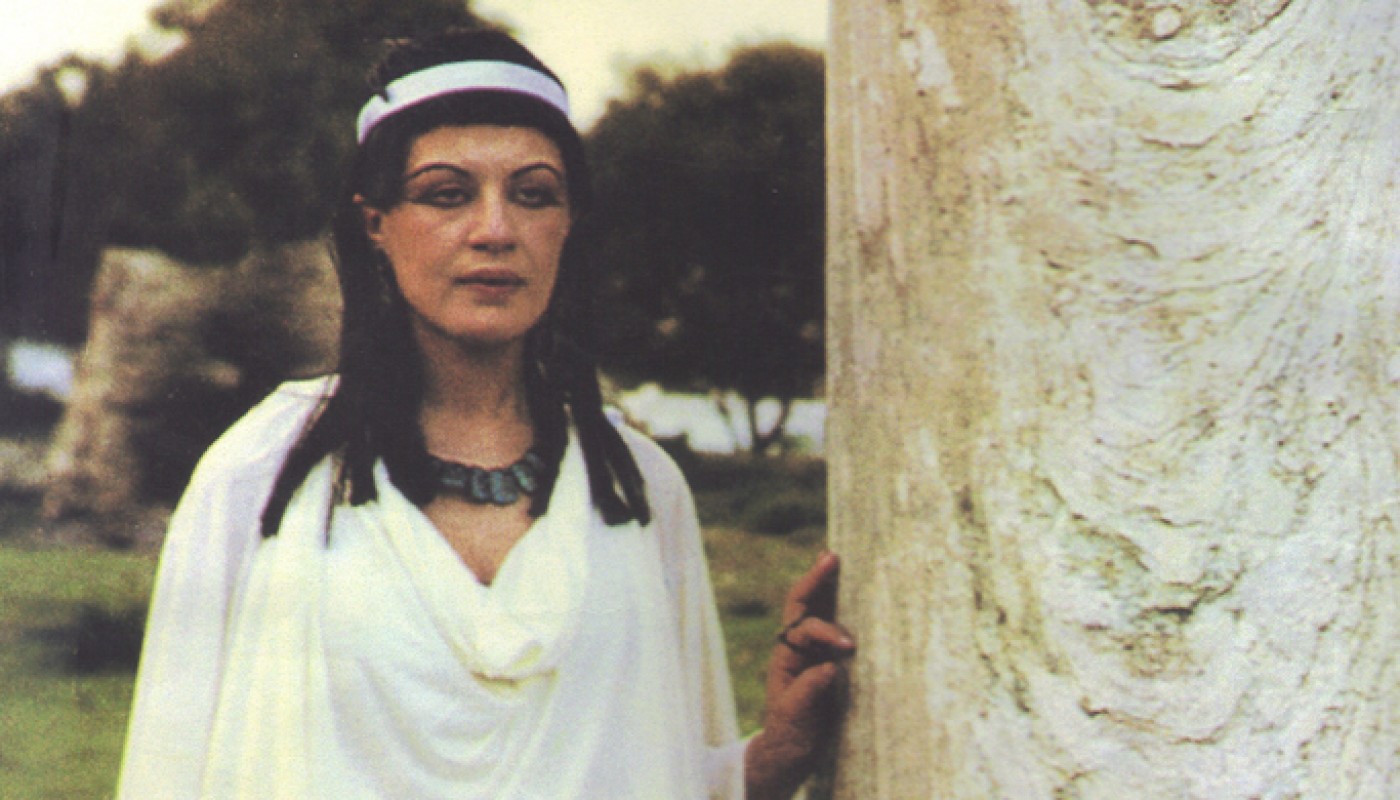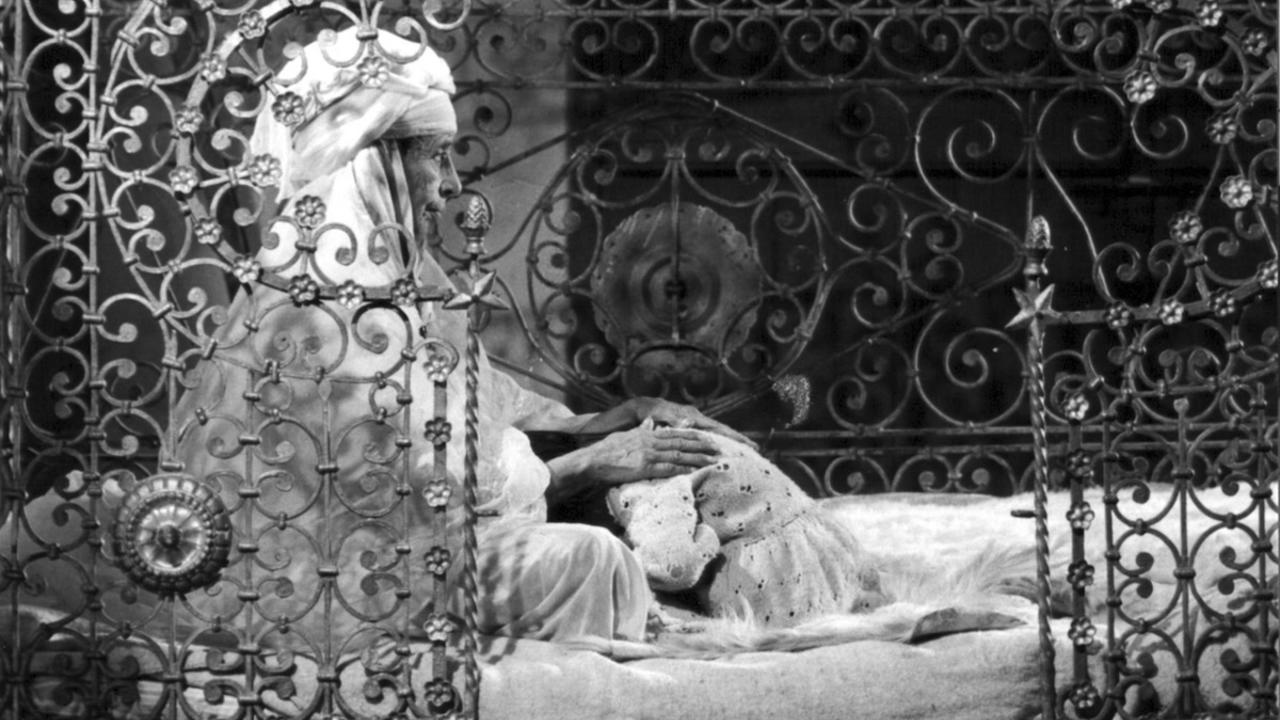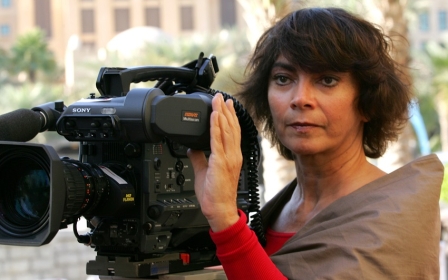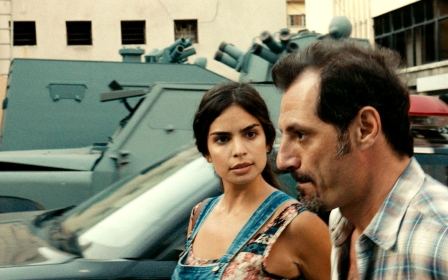Female Arab directors: 11 films that you need to see

To mark Women’s History Month, Indiewire, the popular film industry and review website, has published a list of “The 100 All-Time Greatest Films Directed by Women”.
The expansive list included predictable names: Americans Kathryn Bigelow, Greta Gerwig, Maya Deren and Sofia Coppola; French directors Claire Denis and Agnes Varda; Sarah Polley from Canada; the Belgian film-maker Chantal Akerman; and Lucrecia Martel from Argentina among others.
To give the impression of inclusivity, the American online portal threw in some lesser-known titles: I’m Not a Witch by Zambian Rungano Nyoni; Reassemblage by Vietnamese (and American educated) Trinh T Minh-ha; and the Middle East’s most famous short, The House is Black by Iranian Forough Farrokhzad.
The list favoured the likes of American Jennifer Lee (Disney’s Frozen) and French Mélanie Laurent (Breathe) over less popular titans such as Larisa Shepitko and Kira Muratova from Ukraine or Samira Makhmalbaf from Iran.
But the list’s most glaring omission is its complete lack of Arab film-makers.
Kathryn Bigelow meanwhile has three films on the list, two of which are set in the Middle East (The Hurt Locker and Zero Dark Thirty). Not one film in any format from the region made it to the list. Even with the growing popularity of Arab cinema during the past few decades, and the recent Oscar nominations for Arab female film-makers (Lebanese Nadine Labaki for Capernaum, Egyptian Jehane Noujaim for The Square and Yemini Sarah Ishaq for Karama Has No Walls) the Indiewire voters didn’t deem any Arab film-maker, new or old, worthy of inclusion.
The marginalisation and neglect of Arab voices in Western film criticism is not new. Arab cinema is still treated as an exotic object, often assessed by its politics (which many get wrong) rather than its aesthetics, with many critics struggling to decipher the political subtexts behind the chosen aesthetic or narrative form.
Unlike comment on other forms of cinema, Western writing about Arab cinema is always divorced from its film history and traditions – a reductive tendency responsible for its inevitable exoticism.
There are exceptions to the rule of course, most notably by American critics Jay Weissberg of Variety, Deborah Young of The Hollywood Reporter, Blige Ebri of Vulture, and recently Richard Brody of the New Yorker (who has largely been responsible for the rise in profile of little-known Syrian film-maker, Sara Fattahi), but those are few and far between.
The general critical discourse on Arab cinema has largely been sloppy, misinformed and intellectually lethargic. The same goes for academic writing, which has mostly approached Arab cinema from a socio-political or anthropological perspective, with aesthetics always relegated to a secondary role in the discussion.
Some might argue that knowledge of the history of lesser-known cinemas is not mandatory for understanding or writing about cinema like that of the Arab world, asserting that the critic’s reception towards any film mirrors that of the audience, who do not necessarily have the knowledge of either the political or cultural history of those cinemas.
The list’s most glaring omission is its complete lack of Arab film-makers
But then again, what differentiates film experts from an average viewer if they are not versed in other cinemas?
The most startling aspect of Jean-Luc Godard’s widely discussed The Image Book, an essay film from last year about the legacy of movie history, was the dominance of the western reading of film history, which relegates the “other” cinemas into the ill-defined notion of “national cinemas”, represented by specific internationally recognised film-makers.
The examples are too many: Satyajit Ray in India; Youssef Chahine in Egypt and Africa; Yılmaz Güney in Turkey. For more than half-a-century, the status of these film-makers in the West was never challenged, the wide spectrum of their countries’ cinemas seldom examined.
Ignorance of the Arab world’s female talents comes as no surprise
The following 11 titles – in no particular order - are an introduction to the vast pool of Arab women directors whose films are estimated to constitute half of all independent films produced in the region today.
Their formal invention, shrewd political subtext and remarkable sensitivity shine in an eclectic body of work that act as both an exploration of the different shades of the female Arab experience and a document of the fluctuating political climate of the region.
Various other names could’ve been added to the list: Kaouther Ben Hania, Soudade Kaadan, Joana Hadjithomas, Sarah Francis, Leila Kilani to name a few - but that’s another list.
El Abnoudy: Early shorts (1971 - 75)
To see Egypt in the documentaries of late film-maker Ateyyat El Abnoudy (1939-2018) is to see Egypt as it really is: the mud, the poverty and the inexplicable resilience.
One of the female pioneers of Arab cinema and a leading figure in independent Egyptian film-making, the former lawyer, journalist and actress is better known for her features - Permissible Dreams (1983), Responsible Women (1994) and Days of Democracy (1996) – but it’s her early shorts that best illustrates the radicalism and boldness of her cinema.
In Horse of Mud (1971), Abnoudy records the daily travails of Cairo’s brickmakers; in Sad Song of Touha (1972), she turns her lens towards the capital’s street performers; and in The Sandwich (1975), she presents a snapshot of the modest existence of rural Egypt’s children.
Deviating from the dominant glossy imagery of mainstream cinema, El Abnoudy’s non-judgmental imagery is entrenched in sweat and dirt; physical, confrontational and deeply poetic.
This is reality unpolished, including stark images which got Abnoudy in trouble with both the censors and the media, who often accused her of tarnishing Egypt’s reputation.
Bloody Beans (2014)
The legacy of French colonial rule has been one of the main themes of Algerian cinema since the country gained independence in 1962.
But nothing made before could’ve prepared even the most acquainted of audiences to the sheer madness and singularity of Narimane Mari’s debut feature.
Inspired by William Golding's Lord of the Flies, this quasi performance piece follows a group of children as they begin to protest against their unchanging diet of red beans. Set against a killer soundtrack by electropop duo Zombie Zombie, what unfolds next is a series of hallucinatory sequences laden with symbolism and linked by flimsy narrative drive.
Wild, unpredictable and vexing at times, it may begin as a parable but soon morphs into a meditation on violence, identity and the price of freedom.
Mari’s philosophical enquiries are devoid of ideology, her universal concerns transcending the war of independence, and by default, Algeria itself.
Adored by critics and film programmers yet widely unknown in the Arab world, Mari’s challenging and unorthodox oeuvre have cemented her reputation as the leading Arab avant-garde film-maker working today.
Coma (2015)
Countless documentaries have been made about the Syrian war since its initiation in 2011, yet few have matched the subtle power of Sara Fattahi’s debut feature.
There is no blood nor violence in Fattahi’s interpretation of the war, no refugees struggling in their European exile, no journalists fighting to document Assad’s transgressions.
Coma is shot entirely in Fattahi’s childhood apartment in Damascus where her mother, grandmother and herself were confined for months. Nothing and everything happens in this little bourgeoise prison: the boredom, the endless waiting, the foreboding uncertainty, the precious distractions.
Fattahi brilliantly documents the impact of the war on the uneventful daily existence of the individual, allowing her meticulously curated images to divulge the fears, frustrations and fading hopes of her characters.
Amid desensitised news images which often blur the line between documentation and sensationalism, Fattahi’s films stand out as an act of resistance, not only to the war but to the aesthetic nature of violence.
Coming Forth by Day (2012)
Several contemporary female film-makers have made their mark on Egyptian cinema, including Hala Khalil, Kamla Abu Zikry and Sandra Nashaat to name but a few.
But the distinctive film-making and uncompromising vision of director/producer Hala Lotfy has placed her in a league of her own.
Tracing a day in the life of a lower middle-class mother (Salma Al-Najjar) and daughter (Donia Maher) as they await the death of a paralyzed husband/father (Ahmad Lutfi), the seething tension at the heart of this misleadingly quiet picture is drawn from the tiniest of expressions: a gesture, a look, a brief exchange.
Taking a leaf from the chamber dramas of Ingmar Bergman and the aesthetic spirit of Andrei Tarkovsky, Lotfy’s stationary camera captures an apocalyptic Egypt where individual will is trampled by the sadistic socio-economic powers at play.
The austerity of Lotfy’s visual and crude tackling of familial dysfunction is offset by a palpable humanism that makes her only feature to date the most honest post-January 2011 revolution portrait of the perishing Egyptian middle-class.
Fatma 75 (1975)
The first non-fiction film by a Tunisian female film-maker, Selma Baccar’s ground-breaking feminist essay emerged at a critical moment for women rights in the North African nation.
Baccar’s debut covers three different landmark eras for women’s movements in Tunisia: 1930-38 and the establishment of the Union of Tunisian Women; 1939-1952, when women’s struggles are interwoven with the national struggle for independence; and the period of 1956-1957 and the implementation of the Code of Personal Status that aimed to equate women’s right with those of men.
All three epochs are dramatised from the viewpoint of the titular college student (Jalila Baccar) who is writing an essay about the subject. An unclassifiable docu-fiction which also sees the student play different roles in various other historical epochs, Fatma 75 is an unabashed work of activism, made not only to illustrate women’s centuries-long fight for equality, but also to assert that there was a lot to be achieved in that regard.
The latter sentiment would anger the Tunisian government enough that it banned the film for 30 years.
The Nouba of the Women of Mount Chenoua (1979)
For more than half-a-century, Assia Djebar has been Algeria’s foremost feminist cultural figure. Better known as the acclaimed writer of more than a dozen influential novels such as Les Enfants du Nouveau Monde (1967) and Loin de Médine (1991), Djebar directed only two films, the most well-known of which is The Nouba, the first feature directed by an Algerian woman film-maker.
Adopting the five-movement structure of the eponymous traditional song, Djebar’s freewheeling docudrama is a dialogue between the film-maker and other Algerian women, reflecting on her status at the time and those of her predecessors.
The intentionally disjointed structure carries in its core a reexamination of the deliberately forgotten role of Algerian women in the war of independence; of the unfulfilled promises of the revolution and the subsequent disillusionment of women towards this bitter victory.
The silence of Djebar’s characters is more telling than their direct testimonials, as fragmented memories transpire as the sole tool utilised by an entire generation of women to reclaim their agency.
Now regarded as the most important work of post-colonial Algerian film-making, The Nouba was received with hostility upon its premiere at the Cinemathèque d’Alger and has only been screened once on Algerian TV.
Once Upon a Time, Beirut (1995)
Jocelyn Saab, who died earlier this year, has never received due recognition. Fellow Lebanese Nadine Labaki, Randa Chahal Sabag and Danielle Arbid may be better-known as notable female directors, but it’s Saab who stands out as the most original, most thoughtful and most enterprising of the pack.
Her sophomore effort is a phantasmagoric tale of two young women (Michèle Tyan and Myrna Maakaron) venturing to discover the glorious Beirut of yore, the Beirut of the movies, the Beirut they never knew.
The collective memory of the then-destroyed city, they soon discover, is inseparable from the myth propagated by the movies, a myth that the weathered nation wanted to believe was true.
Comprised of hundreds of film clips, the line separating fact and fiction becomes increasingly distorted, and so does the unity of space and time. Memory has been the central notion of post-war Lebanese cinema. Here, Saab does not investigate the veracity of memory but completely shatters the possibility of its existence.
The Silences of the Palace (1995)
Of all the films made by numerous Arab women film-makers in the past 50 years, Moufida Tlatli’s unparalleled masterpiece The Silences of the Palace (Samt el Qusur) could very well be the greatest of them all.
Tlatli’s Golden Camera winner at Cannes is the Citizen Kane of Arab women’s cinema: the film that changed everything. A damning expose of the sexual favours and social servitude that dozens of women were subjected to during the French protectorate of Tunisia, The Silences of the Palace centres on the daughter (Ghalia Lacroix) of a housemaid (Amel Hedhili) who later discovers that their prince employer (Kamel Fazaa) is her father.
Mystery shrouds nearly every relationship in the drama. Hints are given to understand the characters’ behaviour but never fully explained. The horrors of the story occur outside the frame.
Tlatli compels her viewers to imagine the depravity and violence that occurs in the chambers of the beyys (aristocrats), giving small clues but nothing more.
The Silences of the Palace is a film of disarming subtlety, of repressed anger and conflicting emotions. The result is more daunting and more emotionally devastating, than any straightforward, explicit, treatment of the subject could ever be. It would go on to spawn countless copycats, inspiring women directors across the Arab world and cementing Tlatli’s stature as the most influential female film-maker in Arab film history.
Wadjda (2012)
The hullaballoo that greeted Haifaa al-Mansour’s debut feature – one of the most commercially successful Arab films of all time – was all about the novelty of the affair.
The first feature shot entirely in Saudi Arabia and also the first feature made by a female Saudi director, Wadjda was the ultimate object of exoticism, produced from a country only glimpsed from a western perspective up until then.
Seven years after it took the Venice Film Festival by storm, Wadjda remains as rebellious as ever, a jolting charge against blind patriarchy, religious rule and the dominant culture of fear.
The simple Italian neo-realist-like premise of the film – a headstrong 10-year-old girl (Waad Mohammed) fighting to buy a bicycle – gives way to a penetrating exploration of the position of women in contemporary Saudi society through the roles they’ve been ascribed to, in the physical spaces they’ve been restricted to and in the boundaries they’ve been ordered not to cross. As MBS’s faux reforms prove to be nothing but blown smoke, Wadjda continues to be as urgent as when first released.
Embers (1982)
The first feature by Moroccan film-maker Farida Bourquia has framed the tone for the unwieldy trajectory of a cinema in constant flux.
Set in a remote mountain village, Embers (al-Jamra) is a folk tale about three children orphaned when their parents die in an accident.
Instead of being consoled and attracting sympathy, the trio find themselves shunned by their village who deem them as harbingers of bad luck.
Abundant with elipsises and shrouded with mystery, Bourquia challenges her audience to fill in the gaps of this ambiguous story that relies on suggestion rather than straightforward narrative threads.
A commentary on Moroccan decadent traditions and the hypocrisy of the Arab self-righteous values, Bourquia’s underrated jewel is a masterful exercise in implementing experimental flourishes within a traditional narrative; a beguiling picture that has not lost its power to intrigue.
Wajib (2017)
Palestinian film-maker Annemarie Jacir’s third and best film is not about women at all. A road movie centring on an elderly teacher who embarks on a journey across Nazareth with his returning immigrant architect son to deliver the wedding invitations for his daughter, Wajib is, in equal parts, a piercing account of the inter-generational disconnect between the pragmatism of the old and the fading idealism of the migrant young.
It also serves as a nuanced portrait of the world of middle-class Palestinian men, of wounded machismo, unresolved histories and the unbearable burden of being a man in a traditional society.
Replete with perfectly calibrated dialogue delivered with relish by hugely charismatic real-life father and son thespians Mohammed and Saleh Bakri, Wajib has none of the earnest, if simplistic, nationalistic rhetoric that marred Jacir’s previous outings.
Yes, the defiant resistance demonstrated through sheer survival in the face of occupation, is front and centre, but Wajib is not a film by an outsider looking in.
Rather, it is the work of an artist who has lived in Palestine long enough to know that life is not as black and white, nor as morally definitive, as some might imagine it to be.
Middle East Eye propose une couverture et une analyse indépendantes et incomparables du Moyen-Orient, de l’Afrique du Nord et d’autres régions du monde. Pour en savoir plus sur la reprise de ce contenu et les frais qui s’appliquent, veuillez remplir ce formulaire [en anglais]. Pour en savoir plus sur MEE, cliquez ici [en anglais].


